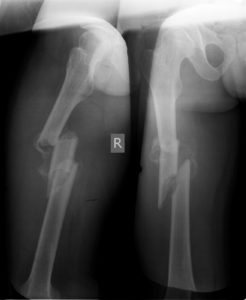Limb Trauma part 2
Bones can break and bend in a few different ways. Different types of fracture can mean different complications and longer-term outcomes. Within the pre-hospital sector, you won’t be able to fully assess what type of fracture it is unless it is a compound fracture. Having an idea of the different types can be useful when making decisions for further care:
Stable fracture – Where the bone breaks and the broken ends line up, barely out of place
Compound fracture – As discussed, where the bone breaks and penetrates the skin
Transverse fracture – Where the fracture follows a horizontal fracture line
Oblique fracture – Where the fracture follows an angled pattern
Comminuted fracture – Where the bone has broken into 3 or more pieces
Pathological fracture – Where the bone has broken due to pathological means, e.g., disease
Stress fracture – Where there is a hairline fracture in the bone
The following fractures occur in children:
Greenstick fracture – The bone bends but doesn’t fracture all the way through
Buckle fracture – Occurs where the bones compress into each other causing one side of the bone to bend
Growth plate fracture – Occurring at the joint where the growth plate is located, this can affect the development of the bone, causing it to be shorter than its’ opposite
Amputations, partial amputations, and degloving – An amputation involves the complete severing of a limb, a partial amputation is an incomplete severing of the limb, and a degloving injury, also called an avulsion injury, is where the top layers of skin and tissue are ripped from the underlying muscle, connective tissue, or bone. When managing:
- Manage any catastrophic haemorrhage. If there is any present, then rapid Primary Survey management of the patient and transport to hospital will be required
- Remove any gross contamination from the site and cover with a saline soaked dressing followed with an occlusive layer
- If there is no catastrophic haemorrhage, where partially amputated, immobilise the limb in a position of normal anatomical alignment
- Don’t irrigate the site in case of forcing contaminant deeper into the tissues and bones
- Reimplantation of a limb or reconstitution of a partial limb amputation may be possible depending on the injury, condition of the limb, affected limb, length of amputation time, and other factors. A limb kept in optimal conditions can possibly be reimplanted numerous hours following amputation. When looking at maintaining limb patency for possible reimplantation, remove any gross contamination from the severed site and cover with a moist dressing, secure the limb in a sealed plastic bag, and place the bag on ice. Make sure the body part isn’t directly touching the ice as this can cause tissue damage
Laceration/Penetration injuries – Laceration and/or penetration injuries can range in severity depending on the MOI and factors involved. A simple laceration where there is no compromise to deeper tissues such as arteries/veins, tendons/ligaments, could be managed within a primary care setting with the use of Advanced Practitioners, or through Minor Injuries at Hospital. Where deeper tissues are affected, hospital admission will be needed to review the damage, and specialists will need to be involved to try and save the limbs’ function and ability.
On reviewing a simple laceration injury:
- Remove any gross contamination and clean where possible
- Place a saline soaked dressing on the wound to prevent any further potential contamination
- Complete all assessments, observations, and paperwork, and review your pathway for further care and treatment
- Some Ambulance Services may have pathways to follow which use Advanced Practitioners or Primary Care service, whereas others may not and a Minor Injuries Unit at hospital will be the only option
Where deeper tissues are affected, the patient will require transport to hospital for further assessment and care:
- Remove any gross contamination and place a saline soaked dressing
- The wound may be bleeding due to deeper tissue damage
- Follow the normal haemorrhage control actions to stop, i.e., applying the dressing with pressure over the wound site, and raise the limb above heart height
Where there has been a penetrating injury or significant laceration, there is the potential for major bleeding to occur. Significant arteries and veins run through the limbs, and a severing of these blood vessels could lead to significant blood loss. If there is bleeding from a penetrating or lacerating wound, follow the basic haemorrhage control steps to manage. If the haemorrhage continues and is unmanageable by basic means, or you feel the haemorrhage is of a catastrophic nature, follow catastrophic haemorrhage protocols:
- Apply a Catastrophic Tourniquet proximal to the site of the injury on viable tissue
- If this fails to stem bleeding, then apply a second tourniquet above the first
- If this fails, pack the bleeding site with haemostatic gauze and apply a fresh dressing with direct pressure
- If this fails, then a rapid transfer to the nearest receiving hospital is required
